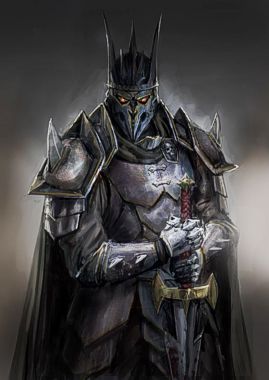

Monstrous Manual

| Climate/Terrain: | Any |
|---|---|
| Frequency: | Very rare |
| Organization: | Solitary |
| Activity Cycle: | Any |
| Diet: | None |
| Intelligence: | Genius (17-18) |
| Treasure: | Nil |
| Alignment: | Chaotic evil |
| No. Appearing: | 1 |
| Armor Class: | 0 |
| Movement: | 12 |
| Hit Dice: | 9 (10-sided dice) |
| THAC0: | 11 |
| No. of Attacks: | 1 with +3 bonus |
| Damage/Attack: | By weapon |
| Special Attacks: | See below |
| Special Defenses: | See below |
| Magic Resistance: | 75% (see below) |
| Size: | M (6-7’ tall) |
| Morale: | Fanatic (17) |
| XP Value: | 6,000 |
A death knight is the horrifying corruption of a paladin or lawful good warrior cursed by the gods to its terrible form as punishment for betraying the code of honor it held in life.
A death knight resembles a hulking knight, typically taller than 6 feet and weighing more than 300 pounds. Its face is a blackened skull covered with shards of shriveled, rotting flesh. It has two tiny, glowing orange-red pinpoints for eyes. Its armor is scorched black as if it had been in a fire. The demeanor of a death knight is so terrifying that even kender have been known to become frightened.
A death knight’s deep, chilling voice seems to echo from the depths of a bottomless cavern. A death knight converses in the language it spoke in its former life, as well as up to six additional languages.
Combat: A death knight retains the fighting skills it had in its former life. Since it has little regard for its own safety and an intense hatred of most living creatures, it is an extremely dangerous opponent. Still, a death knight retains a semblance of the pride it held as a good warrior and fights honorably: It never ambushes opponents from behind, nor does it attack before an opponent has an opportunity to ready his weapon. Surrender is unknown to a death knight, and it will parley only if it senses its opponent has crucial information (such as the fate of a former family member).
A death knight has a strength of 18(00). It usually attacks with a sword; 80% of the time, this is a magical sword. When a magical sword is indicated, roll 1d6 and consult the following table:
| Roll | Death Knight’s Sword |
|---|---|
| 1 | Long sword +2 |
| 2 | Two-handed sword +3 |
| 3 | Two-handed sword +4 |
| 4 | Short sword of quickness |
| 5 | Short sword of dancing |
| 6 | Short sword of life stealing |
A death knight wears the same armor it wore in its previous life, but regardless of the quality of the armor, it always has an AC of 0. Hit points for a death knight are determined by rolling 10-sided dice.
A death knight’s magical abilities make it especially dangerous. It constantly generates fear in a 5-foot radius, and it can cast detect magic, detect invisibility, and wall of ice at will. Twice per day, it can cast dispel magic. Once per day, it can use either power word, blind, power word, kill, or power word, stun. It can also cast symbol of fear or symbol of pain once per day, as well as a 20-dice fireball once per day. All of its magical spells function at the 20th level of ability.
A death knight cannot be turned, but it can be dispelled by holy word spell. It has the power over undead of a 6th-level evil priest. Its magic resistance is 75%, and if an 11 or lower is rolled on the percentile roll, the spell is reflected back at the caster (the magic resistance is rerolled each time a spell is cast at a death knight).
Habitat/Society: Death knights are former good warriors who were judged by the gods to be guilty of unforgivable crimes, such as murder or treason. (For instance, Krynn’s Lord Soth, the most famous of all death knights, murdered his wife so that he could continue an affair with an elfmaid.) Death knights are cursed to remain in their former domains, usually castles or other strongholds. They are further condemned to remember their crime in song on any night when the moon is full; few sounds are as terrifying as a death knight’s chilling melody echoing through the moonlit countryside. Death knights are likely to attack any creature that interrupts their songs or trespasses in their domains.
Ecology: Death knights have no physiological functions. They are sometimes accompanied by skeleton warriors, liches, and other undead who serve as their aides.
